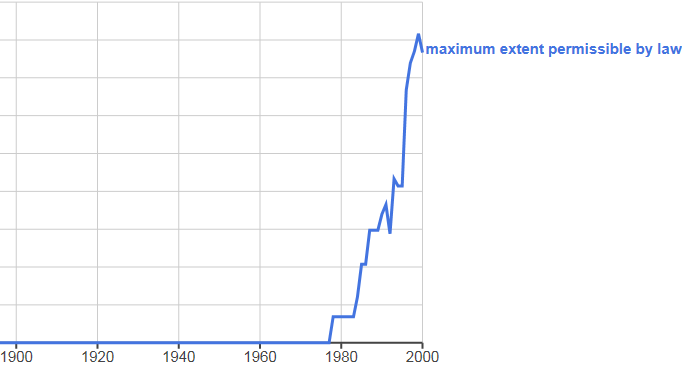To the fullest extent permissible by law: Difference between revisions
Amwelladmin (talk | contribs) m Amwelladmin moved page To the maximum extent permissible by law to To the fullest extent permissible by law Tags: Mobile edit Mobile web edit |
Amwelladmin (talk | contribs) No edit summary Tags: Mobile edit Mobile web edit |
||
| Line 2: | Line 2: | ||
{{quote| | {{quote| | ||
''The Issuer [[to the | ''The Issuer [[to the fullest extent permissible by law]], accepts no liability for the contents of this prospectus...''}} | ||
{{sex|She}} might pause briefly, on that first fumbling encounter, and wonder what legal mischief this [[incantation]] is [[calculated]] to ward off. Does the law assume that any contractual provision is [[deemed]], unless you say to the contrary, to be half-hearted in its intent — a choked nine-iron back onto the fairway from behind a tree, and not a full-throated drive at the green? | {{sex|She}} might pause briefly, on that first fumbling encounter, and wonder what legal mischief this [[incantation]] is [[calculated]] to ward off. Does the law assume that any contractual provision is [[deemed]], unless you say to the contrary, to be half-hearted in its intent — a choked nine-iron back onto the fairway from behind a tree, and not a full-throated drive at the green? | ||
Revision as of 20:01, 15 November 2022
|
The JC’s guide to writing nice.™
|
It won’t be long in the life of a young lawyer before she comes across this delightfully flannelled subordinate clause:
The Issuer to the fullest extent permissible by law, accepts no liability for the contents of this prospectus...
She might pause briefly, on that first fumbling encounter, and wonder what legal mischief this incantation is calculated to ward off. Does the law assume that any contractual provision is deemed, unless you say to the contrary, to be half-hearted in its intent — a choked nine-iron back onto the fairway from behind a tree, and not a full-throated drive at the green?
God only knows, is this commentator’s remark. Actually, let’s face facts: God probably doesn’t know either.
But a bit of research suggests that this gem found its way into the forensic world some time in the late 1970s. And as you’ll see to the right[1], it has flourished since its introduction.
The lilly-liveredness of the statement makes us shudder.
We know for certain that no-one saw fit to make this remark before the 1970s. What is it about the modern world that makes a legal eagle worry so? Does it not, subliminally, sent a contrary message: “I am saying I accept no responsibility but, tacitly, I suppose I realise, at some level, I probably do. You know, that old devil “the law’s fullest extent” might hunt me down and get me.”
Whereas consider the simpler, bolder statement: “The Issuer accepts no liability for this prospectus. None at all. FULL STOP love and kisses xox”
This leaves those disposed to vexatious litigation in no doubt where they stand.
“Okay, okay, I get it. You aren’t responsible. Jesus. Calm down already.”
Now, should it transpire that, for all the Issuer’s bluntest warnings the fullest extent of the law did not allow it off a hook to which the law’s gentler passages might have turned a blind eye — and we quite like the idea there are lazy stretches further down the legal river that aren’t as wet ’n’ wild as its far reaches — then in that case, for investors, happy days; they’re in the money, however terse and to the point the Issuer has been in its disclaimer. But what would the Issuer have gained by tempering its disclaimer with this “fullest extent” vacillation in any case?
And not saying it hardly makes the Issuer’s position worse, does it?
